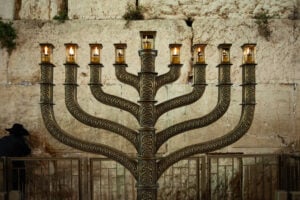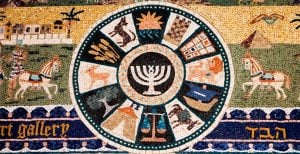The Old City of Jerusalem is one of the oldest cities in the world, and most certainly in Israel. Taking a walk through the Old City, you can find the ancient buildings from Temple times, with shops located inside, selling the modern delights like the Israeli favorite, ice cafe. When it comes to the walls of the Old City, you’ll find a similar mixture. The walls themselves might be as old as time themselves, but each gate has it’s own story, from it’s own time. Today we can see through Jerusalem’s beautiful combination of old and new, the seven open gates into the Old City and one important gate that has been sealed shut.

1. Jaffa Gate

Possibly one of the most famous gate, the Jaffa Gate is located at the end of the incredibly busy Jaffa Road in the city center. The gate was inaugurated in 1538 during the rebuilding of the Old City and looks almost identical as to how it once did with vendors crowding around the gate, trying to tempt hundreds of passer-byes to enjoy their treats. Just on the other side of the gate is the Tower of David and easy access to any of the four quarters in the Old City.
2. The New Gate

Rather obvious from it’s name, the New Gate is the most recently built gate in the Old City, having been completed in 1889. The gate was created during the Ottoman Empire in order to help people reach the Christian Quarter from the new Jerusalem neighborhoods. The Church of the Holy Sepulcher is deep inside the Old City, and this new gate allowed Christians in the Notre Dame Hospice and Russian Compound easy access to their church. In 1948, the gate was closed off by the Jordanians who were in control of Jerusalem, but after the reunification of Jerusalem in 1967, the Israeli’s reopened the New Gate to the public.
3. Damascus Gate

In between the New Gate and Herod’s Gate is the magnificent Damascus Gate, also known as Shar Shchem in Hebrew. This gate got it’s name due to the fact it marked the beginning of the long, no longer existent, road to Damascus, Syria. It was built in 1537 during the Ottoman Empire and is today one of the most used entrances into the Arab Quarter and the Old City. When you walk through, you are filled with the sights, smells and sounds of the busy Arab Quarter bazaar, which has existed there for generations.
4. Herod’s Gate

Another gate on the northern wall of the Old City is Herod’s Gate. The name comes from a Christian background, as it is rumored that Herod Antipas’ church was nearby to this gate. Herod’s Gate is named after Herod Antipas’ church, where Pontius Pilate was said to have sent Jesus. In Hebrew, the gate is called “Flowers Gate” which refers to the flower like stone that decorates the tower. Israeli Antiquities Authority has excavated the area around Herod’s Gate and has uncovered amazing structures, dating as far back to the Second Temple Period.
5. Lions’ Gate

The next incredible gate is the Lions’ Gate. This gate on the eastern wall of the Old City was also built during the Ottoman Empire. The lion emblems on each side of the gate are a mystery as there are different stories of how they came to be, but either way it was done by Sultan Suleiman the Magnificent, a ruler of the Ottoman Empire. At the end of Six Day War, Israeli paratroopers entered through the Lions’ Gate to reach the Temple Mount, and announced that Jerusalem was now in Israel’s hands. Today, we associate the lions on the gate with the symbol of the Kingdom of Judah and the symbol of Jerusalem.
6. Gate of Mercy

Thought to be the oldest gate of the Old City Gates, the Gate of Mercy is the most famous of the closed off gates. This is supposedly where the Messiah will enter into Jerusalem, however it was sealed off at first in 810 and later by the Ottoman Empire in 1541. The Ottomans also created a cemetery outside the Gate of Mercy to prevent a Messiah from coming through, as it says that he would enter through this gate. It is called the Gate of Mercy as it was where the Jews of Jerusalem would pray when they were not able to reach the Kotel during the time of the Crusaders.
7. Dung Gate

For those who take a car to the Kotel (Western Wall), they are no stranger to the Dung Gate as it leads right up to the Kotel. The strange name actually comes from Temple times, as the gate is thought to be built on the area where garbage from the Temple was taken to be burned, as seen in the Book of Nechemia 2:13-14. The Dung Gate was originally built in the 16th Century, widened by the Jordanians in 1952 and renovated once again in 1967 by Israel.
8. Zion Gate

The Zion Gate is one of the seven open gates in Old City. Built in 1540, this southern gate opens up to a view of Mount Zion and is in close proximity to the Tomb of David. This gate leads into the Jewish Quarter and Armenian Quarter of the Old City. The Zion Gate shows scars from the Israeli Independence War as it is speckled with bullet holes. As the British left Jerusalem, they handed the gate’s key to Mordechai Weingarten, the leader of the Jewish Quarter in 1948.
Throughout history, the Old City has had numerous gates that were built and destroyed, as the city itself has gone through the same pain of being destroyed and renewal of being built up again. The current walls of the Old City were built by the sultan Suleiman the Magnificent of the Ottoman Empire during the years of 1535–42 and have stayed almost the same since, with small changes here and there. Hopefully in the years to come, we will not see the walls and gates of Jerusalem fall again but rather continue to be up-kept and beautified.






